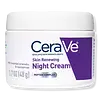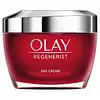What's inside
What's inside
 Key Ingredients
Key Ingredients

 Benefits
Benefits

 Concerns
Concerns

 Ingredients Side-by-side
Ingredients Side-by-side

Water
Skin ConditioningGlycerin
HumectantCaprylic/Capric Triglyceride
MaskingButyrospermum Parkii Butter
Skin ConditioningDimethicone/Vinyl Dimethicone Crosspolymer
Skin ConditioningCyclopentasiloxane
EmollientGlyceryl Stearate Se
EmulsifyingCetyl Alcohol
EmollientDimethicone
EmollientSaccharide Isomerate
HumectantStearic Acid
CleansingPalmitic Acid
EmollientGlycine Soja Sterols
EmollientAllantoin
Skin ConditioningCeramide NP
Skin ConditioningCeramide AP
Skin ConditioningCeramide EOP
Skin ConditioningCarbomer
Emulsion StabilisingNiacinamide
SmoothingCetearyl Alcohol
EmollientBehentrimonium Methosulfate
Sodium Hydroxide
BufferingMyristic Acid
CleansingSodium Lauroyl Lactylate
EmulsifyingSodium Benzoate
MaskingSodium Citrate
BufferingSodium Hyaluronate
HumectantCholesterol
EmollientPhenoxyethanol
PreservativeTocopherol
AntioxidantTripeptide-1
Skin ConditioningLaureth-9
EmulsifyingCitric Acid
BufferingCaprooyl Tetrapeptide-3
Skin ProtectingBiosaccharide Gum-1
HumectantPhytosphingosine
Skin ConditioningXanthan Gum
EmulsifyingDextran
Ethylhexylglycerin
Skin ConditioningButylene Glycol
HumectantWater, Glycerin, Caprylic/Capric Triglyceride, Butyrospermum Parkii Butter, Dimethicone/Vinyl Dimethicone Crosspolymer, Cyclopentasiloxane, Glyceryl Stearate Se, Cetyl Alcohol, Dimethicone, Saccharide Isomerate, Stearic Acid, Palmitic Acid, Glycine Soja Sterols, Allantoin, Ceramide NP, Ceramide AP, Ceramide EOP, Carbomer, Niacinamide, Cetearyl Alcohol, Behentrimonium Methosulfate, Sodium Hydroxide, Myristic Acid, Sodium Lauroyl Lactylate, Sodium Benzoate, Sodium Citrate, Sodium Hyaluronate, Cholesterol, Phenoxyethanol, Tocopherol, Tripeptide-1, Laureth-9, Citric Acid, Caprooyl Tetrapeptide-3, Biosaccharide Gum-1, Phytosphingosine, Xanthan Gum, Dextran, Ethylhexylglycerin, Butylene Glycol
Water
Skin ConditioningGlycerin
HumectantIsohexadecane
EmollientNiacinamide
SmoothingIsopropyl Isostearate
EmollientAluminum Starch Octenylsuccinate
AbsorbentNylon-12
Dimethicone
EmollientPanthenol
Skin ConditioningPalmitoyl Pentapeptide-4
Skin ConditioningTocopheryl Acetate
AntioxidantCeratonia Siliqua Fruit Extract
MaskingCaprylic/Capric Triglyceride
MaskingEthylhexylglycerin
Skin ConditioningSodium Hyaluronate
HumectantDimethiconol
EmollientCetearyl Glucoside
EmulsifyingCetearyl Alcohol
EmollientSodium PEG-7 Olive Oil Carboxylate
EmulsifyingStearic Acid
CleansingPalmitic Acid
EmollientC12-13 Pareth-3
EmulsifyingLaureth-7
EmulsifyingPEG-30 Dipolyhydroxystearate
EmulsifyingSorbitan Oleate
EmulsifyingCeteareth-6
EmulsifyingStearyl Alcohol
EmollientCetyl Alcohol
EmollientBehenyl Alcohol
EmollientArachidyl Alcohol
EmollientDisodium EDTA
Polyethylene
AbrasiveSodium Acrylates Copolymer
Polyacrylamide
Citric Acid
BufferingSodium Hydroxide
BufferingPEG-100 Stearate
Ammonium Polyacrylate
StabilisingTitanium Dioxide
Cosmetic ColorantMica
Cosmetic ColorantTin Oxide
AbrasiveC13-14 Alkane
SolventBenzyl Alcohol
PerfumingMethylparaben
PreservativeEthylparaben
PreservativePropylparaben
PreservativePhenoxyethanol
PreservativeParfum
MaskingLinalool
PerfumingBenzyl Salicylate
PerfumingHexyl Cinnamal
PerfumingLimonene
PerfumingAlpha-Isomethyl Ionone
PerfumingCitronellol
PerfumingWater, Glycerin, Isohexadecane, Niacinamide, Isopropyl Isostearate, Aluminum Starch Octenylsuccinate, Nylon-12, Dimethicone, Panthenol, Palmitoyl Pentapeptide-4, Tocopheryl Acetate, Ceratonia Siliqua Fruit Extract, Caprylic/Capric Triglyceride, Ethylhexylglycerin, Sodium Hyaluronate, Dimethiconol, Cetearyl Glucoside, Cetearyl Alcohol, Sodium PEG-7 Olive Oil Carboxylate, Stearic Acid, Palmitic Acid, C12-13 Pareth-3, Laureth-7, PEG-30 Dipolyhydroxystearate, Sorbitan Oleate, Ceteareth-6, Stearyl Alcohol, Cetyl Alcohol, Behenyl Alcohol, Arachidyl Alcohol, Disodium EDTA, Polyethylene, Sodium Acrylates Copolymer, Polyacrylamide, Citric Acid, Sodium Hydroxide, PEG-100 Stearate, Ammonium Polyacrylate, Titanium Dioxide, Mica, Tin Oxide, C13-14 Alkane, Benzyl Alcohol, Methylparaben, Ethylparaben, Propylparaben, Phenoxyethanol, Parfum, Linalool, Benzyl Salicylate, Hexyl Cinnamal, Limonene, Alpha-Isomethyl Ionone, Citronellol
 Reviews
Reviews

Ingredients Explained
These ingredients are found in both products.
Ingredients higher up in an ingredient list are typically present in a larger amount.
This ingredient is an emollient, solvent, and texture enhancer. It is considered a skin-softener by helping the skin prevent moisture loss.
It helps thicken a product's formula and makes it easier to spread by dissolving clumping compounds.
Caprylic Triglyceride is made by combining glycerin with coconut oil, forming a clear liquid.
While there is an assumption Caprylic Triglyceride can clog pores due to it being derived from coconut oil, there is no research supporting this.
Learn more about Caprylic/Capric TriglycerideCetearyl alcohol is a mixture of two fatty alcohols: cetyl alcohol and stearyl alcohol. It is mainly used as an emulsifier. Emulsifiers help prevent the separation of oils and products. Due to its composition, it can also be used to thicken a product or help create foam.
Cetearyl alcohol is an emollient. Emollients help soothe and hydrate the skin by trapping moisture.
Studies show Cetearyl alcohol is non-toxic and non-irritating. The FDA allows products labeled "alcohol-free" to have fatty alcohols.
This ingredient is usually derived from plant oils such as palm, vegetable, or coconut oils. There is debate on whether this ingredient will cause acne.
Due to the fatty acid base, this ingredient may not be Malassezia folliculitis safe.
Learn more about Cetearyl AlcoholCetyl Alcohol is a fatty alcohol. Fatty Alcohols are most often used as an emollient or to thicken a product.
Its main roles are:
Though it has "alcohol" in the name, it is not related to denatured alcohol or ethyl alcohol.
The FDA allows products labeled "alcohol-free" to have fatty alcohols.
Learn more about Cetyl AlcoholCitric Acid is an alpha hydroxy acid (AHA) naturally found in citrus fruits like oranges, lemons, and limes.
Like other AHAs, citric acid can exfoliate skin by breaking down the bonds that hold dead skin cells together. This helps reveal smoother and brighter skin underneath.
However, this exfoliating effect only happens at high concentrations (20%) which can be hard to find in cosmetic products.
Due to this, citric acid is usually included in small amounts as a pH adjuster. This helps keep products slightly more acidic and compatible with skin's natural pH.
In skincare formulas, citric acid can:
While it can provide some skin benefits, research shows lactic acid and glycolic acid are generally more effective and less irritating exfoliants.
Most citric acid used in skincare today is made by fermenting sugars (usually from molasses). This synthetic version is identical to the natural citrus form but easier to stabilize and use in formulations.
Read more about some other popular AHA's here:
Learn more about Citric AcidDimethicone is a type of synthetic silicone created from natural materials such as quartz.
What it does:
Dimethicone comes in different viscosities:
Depending on the viscosity, dimethicone has different properties.
Ingredients lists don't always show which type is used, so we recommend reaching out to the brand if you have questions about the viscosity.
This ingredient is unlikely to cause irritation because it does not get absorbed into skin. However, people with silicone allergies should be careful about using this ingredient.
Note: Dimethicone may contribute to pilling. This is because it is not oil or water soluble, so pilling may occur when layered with products. When mixed with heavy oils in a formula, the outcome is also quite greasy.
Learn more about DimethiconeEthylhexylglycerin (we can't pronounce this either) is commonly used as a preservative and skin softener. It is derived from glyceryl.
You might see Ethylhexylglycerin often paired with other preservatives such as phenoxyethanol. Ethylhexylglycerin has been found to increase the effectiveness of these other preservatives.
Glycerin is already naturally found in your skin. It helps moisturize and protect your skin.
A study from 2016 found glycerin to be more effective as a humectant than AHAs and hyaluronic acid.
As a humectant, it helps the skin stay hydrated by pulling moisture to your skin. The low molecular weight of glycerin allows it to pull moisture into the deeper layers of your skin.
Hydrated skin improves your skin barrier; Your skin barrier helps protect against irritants and bacteria.
Glycerin has also been found to have antimicrobial and antiviral properties. Due to these properties, glycerin is often used in wound and burn treatments.
In cosmetics, glycerin is usually derived from plants such as soybean or palm. However, it can also be sourced from animals, such as tallow or animal fat.
This ingredient is organic, colorless, odorless, and non-toxic.
Glycerin is the name for this ingredient in American English. British English uses Glycerol/Glycerine.
Learn more about GlycerinNiacinamide is a multitasking form of vitamin B3 that strengthens the skin barrier, reduces pores and dark spots, regulates oil, and improves signs of aging.
And the best part? It's gentle and well-tolerated by most skin types, including sensitive and reactive skin.
You might have heard of "niacin flush", or the reddening of skin that causes itchiness. Niacinamide has not been found to cause this.
In very rare cases, some individuals may not be able to tolerate niacinamide at all or experience an allergic reaction to it.
If you are experiencing flaking, irritation, and dryness with this ingredient, be sure to double check all your products as this ingredient can be found in all categories of skincare.
When incorporating niacinamide into your routine, look out for concentration amounts. Typically, 5% niacinamide provides benefits such as fading dark spots. However, if you have sensitive skin, it is better to begin with a smaller concentration.
When you apply niacinamide to your skin, your body converts it into nicotinamide adenine dinucleotide (NAD). NAD is an essential coenzyme that is already found in your cells as "fuel" and powers countless biological processes.
In your skin, NAD helps repair cell damage, produce new healthy cells, support collagen production, strengthen the skin barrier, and fight environmental stressors (like UV and pollution).
Our natural NAD levels start to decline with age, leading to slower skin repair, visible aging, and a weaker skin barrier. By providing your skin niacinamide, you're recharging your skin's NAD levels. This leads to stronger, healthier, and younger looking skin.
Another name for vitamin B3 is nicotinamide. This vitamin is water-soluble and our bodies don't store it. We obtain Vitamin B3 from either food or skincare. Meat, fish, wheat, yeast, and leafy greens contain vitamin B3.
The type of niacinamide used in skincare is synthetically created.
Learn more about NiacinamidePalmitic Acid is a fatty acid naturally found in our skin and in many plant and animal sources. In cosmetics, it is usually derived from palm oil. It serves many purposes in skincare, acting as a cleanser, emollient, and emulsifier.
As an emollient, palmitic acid helps soften and smooth the skin by preventing water loss. In cleansers, it helps remove oil and dirt while creating foam.
Its emulsifying properties help stabilize products by keeping water and oil-based ingredients from separating.
This may not be suitable for fungal acne-prone skin, as fatty acids like this can sometimes trigger breakouts in sensitive individuals.
Learn more about Palmitic AcidPhenoxyethanol is a preservative that has germicide, antimicrobial, and aromatic properties. Studies show that phenoxyethanol can prevent microbial growth. By itself, it has a scent that is similar to that of a rose.
It's often used in formulations along with Caprylyl Glycol to preserve the shelf life of products.
Sodium Hyaluronate is hyaluronic acid's salt form. It is commonly derived from the sodium salt of hyaluronic acid.
Like hyaluronic acid, it is great at holding water and acts as a humectant. This makes it a great skin hydrating ingredient.
Sodium Hyaluronate is naturally occurring in our bodies and is mostly found in eye fluid and joints.
These are some other common types of Hyaluronic Acid:
Learn more about Sodium HyaluronateSodium Hydroxide is also known as lye or caustic soda. It is used to adjust the pH of products; many ingredients require a specific pH to be effective.
In small amounts, sodium hydroxide is considered safe to use. However, large amounts may cause chemical burns due to its high alkaline.
Your skin has a natural pH and acid mantle. This acid mantle helps prevent harmful bacteria from breaking through. The acid mantle also helps keep your skin hydrated.
"Alkaline" refers to a high pH level. A low pH level would be considered acidic.
Learn more about Sodium HydroxideStearic Acid is a fatty acid. It is an emollient, emulsifier, and texture enhancer.
As an emollient, stearic acid helps soften skin. It aids the skin's protective barrier by preventing water loss. It also provides a gentle cleansing effect without stripping away natural oils.
Stearic acid may also be used to enhance the texture of products. It can add volume and stabilize ingredients such as water and oil. This can help water and oil ingredients from separating.
Sources of stearic acid include animal or vegetable fats/oils such as coconut or shea. It can be naturally found in butter, cocoa butter, shea butter, vegetable fats, and animal tallow.
This ingredient may not be Malassezia folliculitis, or fungal-acne safe.
Learn more about Stearic AcidWater. It's the most common cosmetic ingredient of all. You'll usually see it at the top of ingredient lists, meaning that it makes up the largest part of the product.
So why is it so popular? Water most often acts as a solvent - this means that it helps dissolve other ingredients into the formulation.
You'll also recognize water as that liquid we all need to stay alive. If you see this, drink a glass of water. Stay hydrated!
Learn more about Water